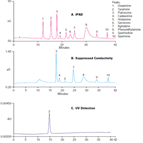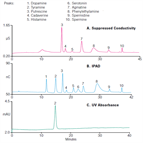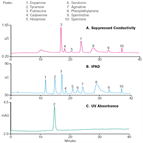Find methods for your needs
Refine by Feature
Displaying 1-3 of 3 results for Tag: Histamine
AN182: Determination of Biogenic Amines in Alcoholic Beverages by Ion Chromatography with Suppressed Conductivity and Integrated Pulsed Amperometric Detections
Instrument Type: ICIn this application, three detectors were employed and compared. An IonPac CS18 column coupled to IPAD to detect biogenic amines in beer and wine samples prior to storage. As relatively little information exists on the accumulation of biogenic amines in alcoholic beverages during storage, refrigerated samples were analyzed using suppressed conductivity detection coupled to IPAD. UV detection was used to confirm the presence of tyramine in some alcoholic beverages. Detectors were also compared in terms of linearity, detection limits, precision, and recovery of biogenic amines spiked in samples.
AU162: Determination of Biogenic Amines in Fruit, Vegetables, and Chocolate Using Ion Chromatography with Suppressed Conductivity and Integrated Pulsed Amperometric Detections
Instrument Type: ICIn this update, the procedures described in AN 183 are used to determine biogenic amine levels in kiwi fruit, spinach, and chocolate. Application Note 183 (AN 183) describes the use of the IonPac CS18, a weak acid cation-exchange column, with suppressed conductivity, integrated pulsed amperometric detection (IPAD), and UV for the detection of underivatized biogenic amines in meat and cheese. The CS18 allows separation of biogenic amines without the use of highly-concentrated acidic eluents or organic solvents while still providing resolution of closely eluting peaks.
AN183: Determination of Biogenic Amines in Fermented and Non-Fermented Foods Using Ion Chromatography with Suppressed Conductivity & Integrated Pulsed Amperometric Detections.
Instrument Type: ICThe IonPac CS18, a polymeric weak acid cationexchange column, was used to separate biogenic amines in a variety of fermented and non-fermented food samples, with detection by IPAD, suppressed conductivity, and UV. The described method uses a simple electrolytically generated MSA eluent without requiring the use of solvents or aggressive eluent systems that have previously been reported. In addition, the method results in good precision and recovery over a wide range of sample matrices and avoids the need for complex and long derivatization procedures.



